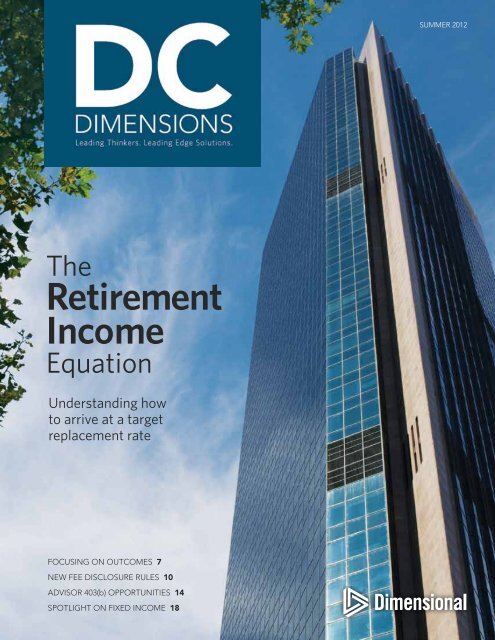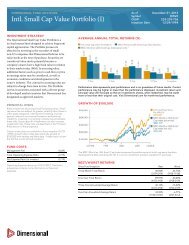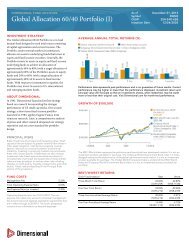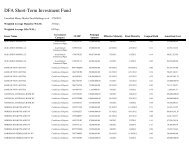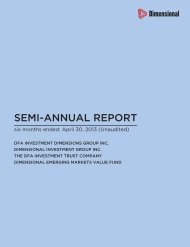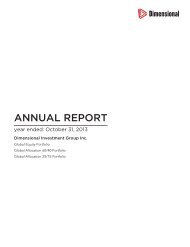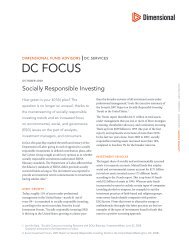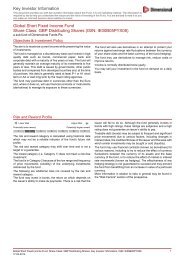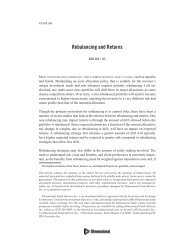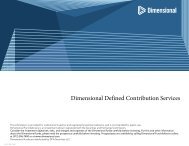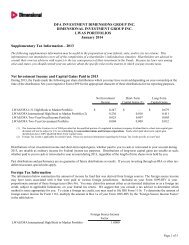Retirement Income - Dimensional Fund Advisors
Retirement Income - Dimensional Fund Advisors
Retirement Income - Dimensional Fund Advisors
- No tags were found...
You also want an ePaper? Increase the reach of your titles
YUMPU automatically turns print PDFs into web optimized ePapers that Google loves.
SUMMER 2012The<strong>Retirement</strong><strong>Income</strong>EquationUnderstanding howto arrive at a targetreplacement rateFOCUSING ON OUTCOMES 7NEW FEE DISCLOSURE RULES 10ADVISOR 403(b) OPPORTUNITIES 14SPOTLIGHT ON FIXED INCOME 18
DC dimensions SUMMER 2012Photo Tyrone BraniganFeature Story: The <strong>Retirement</strong><strong>Income</strong> Equation. ............ 2Global DC:Focusing on Outcomes. ........7DC Research: Fees, Fees,and Finally Fees. ............10401(k) Spotlight:From My Corner. ............13Advisor Focus:Exploring 403(b) Plans. .......14Legal Update: Employees vs.Independent Contractors. ....16<strong>Dimensional</strong> Focus:Spotlight on Fixed <strong>Income</strong>. ...18Fast Facts. .................20Upcoming DC Events. .......21ON THE COVER: <strong>Dimensional</strong>’s Sydney Office, Gateway at 1 Macquarie Place, owned by DEXUS Wholesale Property <strong>Fund</strong>.<strong>Dimensional</strong> <strong>Fund</strong> <strong>Advisors</strong>Palisades West6300 Bee Cave Road, Building OneAustin, TX 78746Phone: (512) 306-7400Fax: (512) 306-7499The views and opinions of the third-party authors do not necessarilyrepresent the views of <strong>Dimensional</strong> <strong>Fund</strong> <strong>Advisors</strong>.The articles are distributed for informational purposes only and should not beconsidered investment, tax, or legal advice or an offer of any security for sale.DC Dimensions is published for institutional and registered investmentadvisor use only. Not for public use. <strong>Dimensional</strong> <strong>Fund</strong> <strong>Advisors</strong> LP is aninvestment advisor registered with the Securities and Exchange Commission.
LETTER FROM THE EDITOR<strong>Dimensional</strong> <strong>Fund</strong> <strong>Advisors</strong> is focused on providing better outcomes for our clients.That’s why we dedicated this issue of DC Dimensions to exploring what “outcomes” meanfor participants in defined contribution (DC) plans. In our feature story, “The <strong>Retirement</strong><strong>Income</strong> Equation,” we highlight recent research by Marlena Lee, PhD, a vice presidentat <strong>Dimensional</strong>, who discusses how her findings can improve your plan’s design. We alsotalk with Paul Yakoboski, PhD, a principal research fellow with the TIAA-CREF Institute, toget his thoughts on the state of retirement and how his company is helping to improveparticipant outcomes. And, in an interview with Australian retirement savings expertMichael Drew, we follow up on our winter 2012 issue by continuing to investigate howglobal retirement innovation is affecting outcomes.As the DC landscape undergoes positive change around the world, this summer marksthe start of a new regulatory framework covering fiduciary obligations and enhanced feedisclosure for DC plans in the US. To better understand the impact of these new rules andregulations, we partnered with the Boston Research Group on an attitudinal-based studyinvolving 250 plan sponsors. We are pleased to present the first study of its kind and thinkyou will find the results especially insightful!For advisors, we feature an article by <strong>Dimensional</strong> regional director Ashish Shrestha onwhat we like to refer to as “the other side of DC,” or 403(b) plans, and a second article by<strong>Dimensional</strong> vice president Apollo Lupescu, PhD, who explores factors impacting advisors’success when marketing DC solutions.Finally, we are proud to continue our timely legal and regulatory updates from IanKopelman, chair of the DLA Piper LLP (US) Employee Benefits & Executive CompensationPractice Group and legal counsel for the Plan Sponsor Council of America (PSCA).Sincerely,Tim KohnHead of DC Services and vice president<strong>Dimensional</strong> <strong>Fund</strong> <strong>Advisors</strong>SUMMER 2012 1
Feature StoryTheThe<strong>Retirement</strong>EquationUnderstanding how to arriveat a target replacement rateBy Marlena I. Lee, PhD, vice president, <strong>Dimensional</strong> <strong>Fund</strong> <strong>Advisors</strong>How much retirement income is enough? The answer dependson a household’s unique needs. If we define successful retirementplanning as the ability to maintain one’s pre-retirement standard ofliving, common advice recommends that households target 75% to85% of pre-retirement income. However, while this can be a usefulstarting point, understanding how to arrive at a target replacementrate can be helpful for future retirees and plan sponsors alike.Those engaged in retirement planning shouldunderstand what is typical for households with similarcharacteristics. This is an improvement over one-sizefits-allfinancial advice. This article also provides aroadmap for how one might adjust the recommendedreplacement rate to fit a unique situation.For plan sponsors, understanding what replacementrate is appropriate for participants is critical in assessinga plan’s adequacy. Benchmarking retirement planswithout controlling for participant characteristics mightlead to faulty conclusions about retirement readiness.The purpose of this study is to provide a framework fordetermining a target replacement rate that will allowa household to maintain its pre-retirement standard ofliving. The study considers actual spending patterns ofthousands of US households while taking into accountuncertainty in investment outcomes and career paths.The results indicate that replacement rates can varywidely, from less than 60% for highly compensatedemployees to over 80% for low-wage earners. Bycomparing the prescribed results to actual behavior, wecan draw conclusions about the feasibility of DC plans asa primary source of retirement income for future retirees.2 DC DIMENSIONS
<strong>Income</strong>The FrameworkCommon sense tells us most people need to replaceless than 100% of their gross pre-retirement income inretirement. While working, income goes to oneof three things: taxes, savings, or spending. However,retirees typically pay fewer taxes and no longerneed to save for retirement. In a simple example, ifa household saved 10% for retirement and had aneffective tax rate of 10% while working and 0% whenretired, an 80% replacement rate would be required inorder to achieve the same level of spending enjoyedbefore retirement.Should people target the same level of spending?A wealth of academic research suggests the answer isno. Economic theory suggests people should targetthe same standard of living; however, this may notmean the same thing as targeting a dollar level ofspending. A simple example would be a homeownerwhose mortgage is paid off before retirement. Sincethe homeowner lives in the same house duringretirement, there is no change in standard of living,but out-of-pocket housing expenses will decline.In such cases, incorporating a decline in spendingmight make sense for some households.Returning to our previous example, suppose thehomeowner decides the pre-retirement standard of livingcan be sustained even if spending declines by 10%. Since80% of gross pre-retirement income was being spent,the change represents a decline of 8% of gross income(10% of 80%). Now the target replacement rate is 72%(100% less 10% for taxes, 10% for saving, and 8% forspending adjustment). The chart below illustrates theframework used in this study to compute replacementrates. By estimating effective tax rates, spending needsto maintain a standard of living, and the appropriatesavings rate needed to support that level of spending,we can solve for target replacement rates.Replacement rates should be less than 100%CONSTANT DOLLARSTaxesSavingsPension income+<strong>Income</strong> from personal savingsSpendingSocial SecurityWORKING YEARSRETIREMENTSUMMER 2012 3
Feature Story: The <strong>Retirement</strong> <strong>Income</strong> EquationRequired savings rates might be lower if a householdis willing to take more risk or target a lower spendinglevel. Alternatively, savings rates might need tobe higher if a person started saving later, did notconsistently save, is more risk averse, or would like totarget higher levels of retirement spending.Putting It All TogetherReplacement rates can differ substantially acrosshouseholds depending on individual retirementgoals, tax rates, and accumulated savings. Using preretirementincome as a sorting variable, we obtainincome replacement rates that range from 58% forhighly compensated employees to about 82% for lowwageearners. Replacement rates decline as incomeincreases for a number of reasons:• High-income households tend to reduce spendingas they transition into retirement.• Tax rates are higher for high-income households.• Social Security replacement rates are lower, thusnecessitating higher savings rates.Households that consistently save throughout theworking years need to target savings rates of 10% to15%—which is not that far off from observed behavior.Among active DC participants in the 2007 Survey ofConsumer Finances, median total contribution rates(including both employee and employer contributions)range from 8% to 12%, depending on income level.Of course, many participants do not save as early andas consistently as in the previous simulations. Thisfact leaves room for improvement, perhaps throughplan design and education. The current trends towardauto-enrollment and auto-escalation are promising,but we believe plan sponsors should remain vigilantabout improving their plans. As we look to the nextgeneration of retirement plans, it’s important to movethe paradigm from savings to consumption planning. nSimulation evidencePercentile of Pre-<strong>Retirement</strong> <strong>Income</strong>< 25th25th–50th50th–75th> 75thPre-retirement income rangeMedian effective tax rateSavings rateSpending adjustment< $25,8708%9%–11%0%< $49,94114%13%–15%0%< $86,88218%12%–14%10%more than $86,88221%13%–16%10%Replacement RateTotalSocial Security81%–83%59%71%–73%38%61%–63%31%57%–59%21%Notesi. Source: US Census Bureau. 2010 Current Population Survey. Annual Social and Economic Supplement.ii.Real changes in per-capita income obtained from Bureau of Economic Analysis. National <strong>Income</strong> and Product Accounts tables. The assumption thatthe household does not defer taxes allows me to complete the analysis without having to make predictions about future tax rates.1. Spending data for 69,827 households are obtained from the Bureau of Labor Statistics Consumer Expenditure Survey; Family-Level Extracts,1980:1–2003:2, compiled by Ed Harris and John Sabelhaus and provided by the National Bureau of Economic Research. Values are converted to real2010 dollars using CPI-U from the Bureau of Labor Statistics.2. Median discretionary expenses by income quartiles. <strong>Income</strong> quartiles are based on the average of the three highest observations of total householdincome. The 25th, 50th, and 75th percentiles of income are $25,327, $49,755, and $93,980, respectively. Sample contains 12,625 observations. Source:RAND HRS, waves 1-9 and HRS CAMS 2001–2009.3. The figure shows median out-of-pocket medical expenses by income quartiles. Sample contains 11,995 observations. Source: RAND HRS, waves 1-9and HRS CAMS 2001–2009.4. The figure shows median nondurable spending by income quartiles. Sample contains 5,356 observations. Source: RAND HRS, waves 1-9 and HRSCAMS 2001–2009.ReferencesAguiar, Mark and Erik Hurst. 2007. Lifecycle prices and production. American Economic Review (97) 1533–59.Aguiar, Mark and Erik Hurst. 2008. Deconstructing lifecycle expenditure. NBER working paper series #13893.Thurow, Lester. 1969. The optimum lifetime distribution of consumption expenditures. American Economic Review (59) 282–297.6 DC DIMENSIONS
the status quo). As trustees, weneed to be unashamedly focusedon asset allocation, informed bymember outcomes. With the righttools (technology, best-in-breedinvestment management) and skills,it is possible to build better low-costsolutions now. All we really need is abit of courage. The second lever ishelping members to make goodfinancial decisions—and avoidbad ones. It is important that ourspending on member educationaligns directly to engagementaround outcomes, such asincome replacement.DC Dimensions: How doesthe management of retirementfunds need to change betweenthe accumulation and thedrawdown phases?Drew: First of all, we think ofretirement saving as a wholeof-lifeproblem (or “through”in the vernacular). This is notto say that these two phasesare artificial concepts. They aredistinct because the dynamicsare different. In the accumulationphase, one is contributingand earning returns, causing astrong positive compoundingeffect (the portfolio size effect),whereas in the drawdown phase,contributions have (usually) ceasedand the account is being drawnupon. Also, the change in taxstatus for Australian members isan important consideration forinvesting in the post-retirementphase. What results is a sort ofreverse compounding, which canbe devastating when combinedwith a drawdown in the first fewyears of retirement. As a result,we believe that managing thedrawdown phase begins ten tofifteen years before retirement andcontinues for the first fiveor so years into retirement.DC Dimensions: How do wemanage the tension betweensimplifying the system, as requiredby the federal government,and providing more flexible,personalized solutions?Drew: Plan sponsors should leaveno stone unturned in managingtheir fund, provided it is donein the interests of the members.More specifically, this approachmight include targeted adviceon plan design, dynamic assetallocation advice, and even someform of portfolio insurance.People seem to be comfortablewhen it comes to insuring theirresidences, but then they becomesingularly focused on cost when itcomes to their portfolios. Surelyafter-tax, after-fees outcomes, andnot just cost, is the right focus.$1,4001,2001,000800600400200For some members, financialplanning might be the answer,and I think funds will continueto provide access to this service.And, finally, trustees should stoplooking for the silver bullet; thereisn’t one. DC plan trusteeship is atough job.DC Dimensions: What is the nextfrontier in your own and others’research into these issues?Drew: Much more can bedone regarding risk measurementand how these measures canbe used in designing optimallifecycle investment strategies.I think the drawdown phase isgenerally under-researched, andthere is more work to be doneregarding the place of variousasset classes throughout theinvestment lifecycle.A key deficiency of the DCframework is that there isgenerally no facility for sharinglongevity risk. Research that leadsto DC plans feeling more DB-likewill be well received. nAustralian Superannuation savings (AUD, billions)0Jun–88 Jun–90 Jun–92 Jun–94 Jun–96 Jun–98 Jun–00 Jun–02 Jun–04 Jun–06 Jun–08 Jun–10Source: Australian Bureau of StatisticsSUMMER 2012 9
<strong>Dimensional</strong> <strong>Fund</strong> <strong>Advisors</strong>’ office in Sydney, Australia.managers, and finally consultants,top of the list of “helpers.”Implications for the IndustryOur study indicates that plansponsors approach 2012 andbeyond ready to make changesand enlist the help of experts.Historically, plan changes (addingor removing a fund or serviceprovider) run at about 10%—meaning only one in ten plansactually tweak their plan every year.Our survey points to 2012 and 2013as having the potential to be oneof the most active times since the2006 Pension Protection Act. Overthe next twelve months, 42% ofplan sponsors are looking to makechanges to their plan by offeringlower investment managementfees to their participants. Finally,we see these changes happeningwith the help of industry experts;most notably, four in ten planswill seek the help of an advisor orconsultant to better understandor construct better offerings.Financial advisors are wellpositioned to help plansimplement new solutions thatresult in lower investment,recordkeeping, and “all-in”fees, and to help create a moretransparent total fee picture. n<strong>Dimensional</strong> Can Help You!<strong>Dimensional</strong> <strong>Fund</strong> <strong>Advisors</strong> has recently joined forces with the PlanSponsor Council of America (PSCA) and Zvi Bodie, a finance professor atBoston University, to create a “Best in Class” DC Plan Design EducationalSeries. This series consists of ERISA fiduciary modules, presented by thePSCA, and Best in Class DC plan design modules, presented by Dr. Bodie,focused on human capital, the true risk in DC plans, and top concernsaround traditional glidepaths and next generation defaults. For moreinformation or to register, please see page 21.Fee DisclosureOverviewThe Department of Labor addressedconcerns around fee transparencywith two distinct regulations:• “408(b)(2)” regulates provider-tosponsordisclosure requirementsand is effective July 1, 2012.• “404(a),” which follows 408(b)(2),regulates sponsor-to-participantdisclosure and is effectiveAugust 30, 2012.The final rule requires coveredservice providers (CSPs) to provideresponsible fiduciaries withinformation they need to:1. Assess reasonableness of totalcompensation, both direct andindirect, received by the CSP, itsaffiliates, and/or subcontractors.2. Identify potential conflictsof interest.3. Satisfy reporting and disclosurerequirements under Title 1 of ERISA.As noted, CSPs are required todisclose relevant information toplan sponsors by July 1, 2012. Plansponsors are then required to provide“plan-level” and “investment-level”information no later than August 30,2012, to plan participants.This article is intended to be informational only, and not as a means of providing legal advice. Planfiduciaries and service providers should consult with their own counsel for advice on complianceand applicable laws and regulations.For more information,please see the DOL’sFact Sheet and FAQ at:http://dfaus.com/fee-rules.12 DC DIMENSIONS
401(k) spotlightFROM MY CORNERA senior economist with the TIAA-CREF Institute speaks outon creative ways to improve today’s defined contribution plansBy JOHN LESSLEY, regional director, <strong>Dimensional</strong> <strong>Fund</strong> <strong>Advisors</strong>Paul Yakoboski, PhD, is a principal research fellow with the TIAA-CREFInstitute, an organization committed to knowledge-building and publicengagement on lifetime financial security, retirement planning, and organizationalsuccess in higher education and the charitable and public sectors. He conducts,manages, and communicates research on issues such as income and assetmanagement in retirement and defined contribution plan design.DC Dimensions: What are thegreatest challenges facing workersas they plan for retirement?Paul Yakoboski: The greatestchallenge is to understandthe amount that needs to besaved. Employer and employeecontributions need to total about12% annually if a worker is goingto replace 70% of pre-retirementincome in retirement. As workersnear retirement, the challenge isdeciding how to convert savingsinto income during retirement.DC Dimensions: What role doesthe employer play in helpingemployees plan for retirement?Yakoboski: Our initial objectiveshould be to create retirementsavers. The ultimate objectiveshould be to create retirementplanners who save accordingly. Theformer can be done with defaults—auto-enrolling workers into a planat a specified contribution levelwith contributions allocated to adefault investment. But the defaultcontribution and investment arenot going to be the “right answer”for most participants. We want tocreate a framework that ideallyleads participants to make informeddecisions about their contributionrates and asset allocations.Providing projections for aretirement income range is a meansthat can be leveraged. But at theend of the day, many individualssimply want to be told what to do.The industry needs rubrics andframeworks that confront this reality.DC Dimensions: Where dotraditional QDIA savings vehiclesfall short in preparing planparticipants for better outcomes,and what can be done to createbetter solutions?Yakoboski: Typical QDIA savingsvehicles face the same risks asany other investment options.At TIAA-CREF we believe oneshould consider the concept ofincome replacement in retirement.In other words, we’re advocatingfor a plan that, along with savingsand asset accumulation, offersparticipants advice, education, andrisk-managed investment options,including a low-cost fixed annuityoption that ensures, along withSocial Security, enough income inretirement to cover expenses. nFor more information about the TIAA-CREF Institute, please visit www.tiaa-crefinstitute.org. The material is for informational purposes only and should not beregarded as a recommendation or an offer to buy or sell any product or service to which this information may relate. Certain products and services may not beavailable to all entities or persons. TIAA-CREF Individual & Institutional Services, LLC and Teachers Personal Investors Services, Inc., members FINRA, distributesecurities products. ©2012 Teachers Insurance and Annuity Association-College <strong>Retirement</strong> Equities <strong>Fund</strong>, New York, NY 10017.SUMMER 2012 13
ADVISOR FOCUSEXPLORING 403(b) PLANSBy Ashish Shrestha, regional director, <strong>Dimensional</strong> <strong>Fund</strong> <strong>Advisors</strong>IRS Section403(b) allowsemployees ofpublic schoolsand certain501(c)(3)nonprofitorganizations, such as hospitals,religious organizations, andmuseums, to make tax-deferredretirement plan contributions.These plans have their owndistinct features, althoughtheir contribution limits anddistribution requirements aresimilar to those of 401(k) plans.This marketplace can presentsignificant opportunities forindependent advisors.<strong>Advisors</strong> may provide plan-levelservices (investment selectionand monitoring, model portfolioallocations, periodic plan reviews,etc.), as well as participant-levelservices (education, advice, etc.).The notable differences between401(k) and 403(b) plans relate toERISA status and vendor selection:• Some nonprofit employers mightchoose to limit their involvementwith the 403(b) plan to avoid beingsubject to ERISA. For example,an employer may facilitatesalary deferral contributions toa 403(b) but refrain from makingdiscretionary decisions about asingle provider, plan design, oremployer-funded contributions.As a result, many non-ERISA 403(b)plans have multiple providers fromwhich participants can choose,rather than the single providermodel typical for 401(k) plans.• At the plan level, the decisionmakingprocess, board dynamics,and internal politics might bedifferent, particularly in publicschool districts. <strong>Advisors</strong> shouldhave a good grasp of theDespite these considerations,there may be invaluable businessopportunities. More and more403(b) plans are choosing to comeunder ERISA or to operate in amanner similar to ERISA plansand the single provider model.Plus, larger service providersare becoming more proactive inengaging independent advisors tocapture mutual opportunities.“Many ERISA 403(b) plancommittees and HR personnel maybe unaware of the advancementsin plan investments, administration,and recordkeeping that have“These plans are in need of theindependent and transparentadvice and services being offeredin the 401(k) marketplace.”— Sarah Simoneaux, principal at SCS Consultingissues facing the board, how tocommunicate with the committees,and ways to reduce the chanceof being replaced as new boardmembers get involved. At theparticipant level, gathering assets inplans with multiple providers mightrequire substantially more effort.so dramatically changed 401(k)plans,” says Sarah Simoneaux,former president of ASPPA andprincipal at SCS Consulting.“These plans are in need of theindependent and transparentadvice and services being offeredin the 401(k) marketplace.” nThis information is intended expressly for discussion purposes only and should not be misconstrued or otherwise interpreted as legal advice.Please consult with qualified legal or ERISA professionals.14 DC DIMENSIONS
ADVISOR FOCUSTHREE KEYS TO 401(k) SUCCESSBy Apollo D. Lupescu, vice president, <strong>Dimensional</strong> <strong>Fund</strong> <strong>Advisors</strong>Independentadvisors havebeen gainingground in thecompetitive401(k) business,especially inthe small-plan market. By adoptingstrategies that improve on the statusquo and by providing quantifiablebenefits, elite advisors can keep uptheir momentum. Here are three keyfactors that can drive success:1. ComprehensiveValue PropositionIndependent advisors sell theirservices rather than products, andprovide an alternative to “bundled”plans that dominate the small-planmarket. By removing conflicts ofinterest, advisors can select theoptimal recordkeepers, third-partyadministrators (TPAs), investmentmanagers, and custodians. Thistransparent “open architecture”model provides an integratedsolution to the plan sponsor.Heather Hooper, vice president ofretirement strategies at Loring WardTotal <strong>Retirement</strong>, believes in theimportance of building a “team ofdedicated subject matter expertsto review each opportunity andask strategic discovery questions.”From an investment perspective,advisors can lower costs byusing institutional share classesand providing participants withprofessionally managed, globallydiversified portfolios. Acting solelyin the interest of the client alsoallows advisors to provide ERISArisk management services andaccept fiduciary responsibilitiesto varying degrees. <strong>Advisors</strong> candeploy top-notch educationalservices and advice to participants,too. “The ability to bring all of thistogether is the core of our valueproposition,” says Fredrick J.Livingston, president of PlanmarkFinancial Group in Atlanta.2. Effective ExecutionThe most successful advisorsunderstand that the 401(k) businessis based on relationships and service,not transactions. “Participant servicesare also offered by our competition,and the key differentiator is that we<strong>Retirement</strong> Plans: Old Style vs. Modern1. Business model2. Assistance withplan administrationand design3. Investmentmanagementservices4. Services forplan participants5. ERISA fiduciaryrisk managementOLD STYLEOpaque, bundled offeringthat might lead to conflictsof interestLimited flexibility in theplan design and selectionof providersFocus on funds andproprietary productsInconsistent, and in manycases non-existentLimited scope, or no statedfiduciary responsibilityactually do it, including meeting withall employees who want to meet,”says Dan Gutierrez, principal at PGRSolutions in northern California.Other elements that engendersuccess: finding the right partners(such as advisor turnkey solutions),marketing your practice as retirementplan specialists, and developing asystematic growth strategy.3. Competing on ValueAn advisor who has a higher costthan competitors should pointout his additional services—orthe elements missing from others.“Building your value propositionaround costs is a losing strategy,”Livingston says. “There is always alower-cost alternative. We aim notto be the lowest-cost provider, butthe best-value provider.” nMODERNIndependent, openarchitecture and fulltransparencyIdentification of optimalpartners; custom plandesign and administrationInstitutional funds andprofessionally managedallocationsMutually agreed-uponservice plan customtailoredto plan’s needsAssume fiduciaryresponsibility, no conflict ofinterest, and full disclosureSUMMER 2012 15
“Workermisclassificationhas become a hottopic in Washingtonand state capitals.”— Ian Kopelmanprospectively reclassify the workersas employees for employmenttax purposes, it may be able tosubstantially reduce its liability forthe prior misclassification by filingan application with the IRS underthe voluntary compliance programestablished last year. However,participation in the program onlyaddresses liability for employmenttaxes. It provides no protectionfrom claims for benefits.An employer can address potentialliability for benefit claims bymisclassified employees in twoways. The first and most obviousway is to make sure workers arecorrectly classified and include anyreclassified workers in the benefitplans prospectively. The secondis to make sure that the eligibilityand administration sectionsof each plan include certainprovisions. To date, the majorityof courts addressing misclassifiedemployees’ claims for retroactivebenefits have decided in favorof the employer based on theplan’s specific terms. The courtshave denied retroactive benefitswhen the plan’s terms specificallyprovided (a) that independentcontractors were not eligible forbenefits and (b) that the planadministrator had the authority tointerpret the terms of the plan inits sole discretion.This language provides a basisfor denying retroactive benefitsto misclassified employeesbecause a plan may excludeemployees as long as it satisfiesthe Internal Revenue Code’sminimum participation andcoverage standards, and a planadministrator with completediscretion to interpret the plan’sterms has the right to determineif an individual employee meetsthe plan’s eligibility requirements.Under these circumstances, a courtwill defer to the administrator’sdetermination unless it finds thatit was arbitrary and capricious.Plan sponsors with a significantindependent contractorworkforce may want to bolstertheir argument by revising aplan’s eligibility provision sothat it excludes independentcontractors, regardless of whetherthey have been determined to beemployees for other purposes by agovernment agency.Finally, it should be noted thatwhile this column and most ofpublic concern about the issueof misclassification focuses onthe consequences of misclassifyingan employee as an independentcontractor, the opposite situationis also problematic. Misclassifyingindependent contractors asemployees eligible to participatein a benefit plan means thatsome participants aren’t actuallyemployees. If non-employees areparticipating in a retirement plan,the plan is operating in violationof its terms and the InternalRevenue Code.ConclusionNo matter what a particularcompany’s situation may be, itis clearly time to take a second,or even third, look at how it usesindependent contractors and totake steps to minimize potentialliability—before the governmentshows up on the doorstep. nExcerpted and adapted from the March/April2012 edition of Defined ContributionsInsights, with permission of the PlanSponsor Council of America.This information is intended expressly fordiscussion purposes only and should not bemisconstrued or otherwise interpreted as legalor tax advice. Please consult with qualifiedlegal or tax professionals regarding yourindividual circumstances.SUMMER 2012 17
DIMENSIONAL FOCUSSPOTLIGHT ON FIXED INCOMEBy TOM GOODRUM, CFA, vice president and fixed income strategist, <strong>Dimensional</strong> <strong>Fund</strong> <strong>Advisors</strong>It’s notuncommonfor definedcontribution(DC) plansto offer anextensiveselection of fixed incomeoptions—not all of which arenecessarily relevant to DCparticipants. Rather than abewildering array of specializedstrategies, DC plan sponsorsmay prefer to focus on a limitedset of options that fulfill the corefunctions of fixed income in adiversified portfolio. This approachallows participants to tailor theirportfolios to reflect their individualrisk tolerances, improving theoverall diversification of theirportfolios and moderating thevolatility of equity holdings.Daily pricing and participanteducation in DC plans also makewell-diversified, highly liquid, lowvolatilityfixed income options moreappealing to plan sponsors thancomplex strategies that aggressivelyseek the highest potential yields. Inaddition, plan sponsors generallydesire a transparent, disciplinedinvestment management processand cost effectiveness.MARKET-DRIVEN APPROACHOver nearly thirty years,<strong>Dimensional</strong> has developeda market-driven approach tofixed income investing based onrigorous research. Rather thanattempting to forecast futureinterest rates or changes in theshape of the yield curve, weconstruct portfolios based onobservable market data. Empiricaldata shows that the current yieldcurve contains information aboutfuture expected return differencesbetween bonds of differentmaturities. The “variable maturity”approach used in most of ourfixed income products applies thisinformation to determine optimalmaturities and holding periods.The portfolios’ average maturitiesshift as the shape and direction ofthe yield curve changes.Similarly, <strong>Dimensional</strong>’s approachto taking credit risk is based onthe idea that market prices arefair. We employ a “variable credit”strategy to structure the portfolios’investment-grade credit exposure,based on spreads betweendifferent credit-quality yields andgovernment bonds of comparableterms. Observable data shows thatbond prices generally incorporatethe deterioration or improvementof credit quality and move well inadvance of announced changes ofopinion by the ratings agencies.SOURCES OF ADDED VALUE<strong>Dimensional</strong> seeks to add value inour fixed income strategies relativeto the benchmarks by using theinformation revealed in currentyield curves to determineperiods when exposure to termand credit risk is expected togenerate higher returns for the<strong>Dimensional</strong> seeks to add valuein our fixed income strategiesrelative to their benchmarks byusing the information revealedin current yield curves.amount of risk taken. Put simply,<strong>Dimensional</strong> believes in taking riskonly when we anticipate gettingpaid for it.For example, we extend maturities(within the fund’s permitted range)when there is an anticipated rewardfor doing so, such as when theyield curve is steep. We shortenmaturities when the curve is flat orinverted. Similarly, when spreadsare wide, we take more credit risk18 DC DIMENSIONS
within allowable ranges; whenspreads narrow and expectedreturns shrink, we reduce creditrisk and emphasize the highestqualityissuers.Our investment approach alsoemphasizes broad diversification,which helps reduce uncertaintyand control risk. Diversificationallows for more efficient portfoliomanagement and trading too.Since our approach is not basedon the time-sensitive tradingof specific bonds, traders havethe flexibility to substituteamong a large pool of securitieswith similar characteristicsselected by portfolio managers.<strong>Dimensional</strong>’s traders can patientlyand strategically pursue pricemovements caused by short-termfluctuations in supply and demand.By providing liquidity to buyersand sellers willing to cross thespread, our traders can capturethat premium.ADVANTAGES OFDIMENSIONAL’S APPROACHUsing observable data todetermine the portfolios’exposures to the twodemonstrated dimensions ofexpected return—term andcredit—results in an unambiguousand disciplined exposure to thesesources of return. This approachseeks to eliminate the speculationand bias that characterize the fixedincome strategies of many otherinvestment managers.By not focusing on interest-ratebets or aggressively pursuinghigh-yield securities, <strong>Dimensional</strong>seeks to avoid the potential risks ofhard-to-price or illiquid exposures.Instead, our bond portfolios areprimarily composed of highquality,readily tradable securities.At the same time, our approachcan be less costly than indexingfrom a portfolio managementperspective. We provide broadexposure to the asset class withoutthe excess transaction costsinvolved in trying to replicate anindex that includes less liquidsecurities. Our trading strategiesnaturally lead to an emphasis onlarger and more liquid issuers.Benefiting from a market-drivenapproach supported by rigorousacademic research and nearly thirtyyears of experience managingfixed income, <strong>Dimensional</strong>’s USand global fixed income strategiesare cost-efficient options for a widerange of investors, particularly fordefined contribution plans. nInflation-ProtectedStrategiesPlan sponsors are increasinglyrecognizing that definedcontribution (DC) savings arelikely to be a major source ofincome in retirement for today’semployees. Treasury Inflation-Protected Securities (TIPS) canbe an efficient way to helppreserve the purchasing powerof that income.<strong>Dimensional</strong>’s Inflation-ProtectedSecurities Portfolio (DIPSX)offers exposure to US Treasurybackednotes and bondswhose principal amounts adjustperiodically to reflect changesin consumer inflation. Theseadjustments deliver preservationof purchasing power to investorsover time. Further, the securitieswill, at the least, mature at facevalue should there be a periodof deflation. The protectivefeatures of TIPS may presentattractive asset allocationopportunities to investors ineither the accumulation orspending phases of their lives.Additionally, <strong>Dimensional</strong>’sefficient portfolio managementapproach for TIPS allows forlow expense ratios. For moreinformation, please contact a<strong>Dimensional</strong> representative.<strong>Fund</strong> investment risks include loss of principal and fluctuating value. Fixed income securities are subject to increased loss of principal during periods ofrising interest rates. Fixed-income investments are subject to various other risks, including changes in credit quality, liquidity, prepayments, and otherfactors. International investing involves special risks such as currency fluctuation and political instability. These risks are described in the Principal Riskssection of the prospectus. Diversification does not eliminate the risk of market loss.Consider the investment objectives, risks, and charges and expenses of <strong>Dimensional</strong>‘s funds carefully beforeinvesting. For this and other information about the funds, please read the prospectus carefully before investing.Prospectuses are available by calling <strong>Dimensional</strong> <strong>Fund</strong> <strong>Advisors</strong> collect at (512) 306-7400 or at www.dimensional.com. <strong>Dimensional</strong>’s funds are distributed by DFA Securities LLC.SUMMER 2012 19
FAST facts“Finance is like medicine: People do not like it, rely on expertadvice, and see choice as a mixed blessing.” (Bodie and Prast, 2007)55% of working adults saythey are willing to pay more out ofeach paycheck to ensure they haveENOUGH MONEY INRETIREMENT.Nearly two-thirds ofworkers are interested inlearning more about howthey could useANNUITIESas part of their401(k) plan.40% of people livepaycheck to paycheck, and 45% of theworkforce says they could not coverfinancial obligations for more than amonth if they lost that paycheck.Nearly four in ten US adultsages eighteen and over don’thave ANY FINANCIALINVESTMENTS, like 401(k)sor IRA retirement accounts, mutualfunds, or stocks.By 2050, more than 600,000Americans will be living to100 YEARS OLD.44% OF PLAN SPONSORSrate helping employees retire withsufficient assets as a top priority.This year, 57% of plan sponsors expect to conduct educationcampaigns designed to INCREASE PARTICIPATION.A majority of Americans,including those on the cuspof retiring, are not confidentthat they know how muchANNUAL INCOMEtheir savings will generateonce they retire.Compiled by Aaron Borders, regional director, <strong>Dimensional</strong> <strong>Fund</strong> <strong>Advisors</strong>.Sources: US Census Bureau, Metlife, CouponCabin, Towers Watson, AON Hewitt, Diversified RRP 2011, http://www.amazon.com/Reforming-Pensions-Principles-Policy-Choices/dp/0195311302.ABOUT DIMENSIONAL:Now in its thirty-first year, <strong>Dimensional</strong> <strong>Fund</strong> <strong>Advisors</strong> is a global institutional assetmanagement firm with around-the-clock trading capabilities out of offices in Austin,Santa Monica, London, and Sydney. The firm also has offices in Vancouver, Amsterdam,and Berlin. <strong>Dimensional</strong> acts as investment advisor, or sub-advisor, for hundredsof financial advisor and institutional clients, including corporate defined benefit anddefined contribution plans, public retirement plans, family offices, financial institutions,endowments, and foundations. As of March 2012, the firm managed about 250 investmentvehicles and had approximately $245 billion in assetsunder management, including $18 billion in DC assets.20 DC DIMENSIONS
UPCOMING DC EVENTS | 2012JULAUGSEPTOCTNOVDECJuly 11-12 | Santa Monica, CA<strong>Dimensional</strong> Advisor 401(k) WorkshopJuly 15-18 | Seattle, WAWestern Pension Benefits ConferenceJuly 26 | Boston, MAZvi Bodie/<strong>Dimensional</strong> <strong>Fund</strong> <strong>Advisors</strong>DC Educational SeriesAugust 23 | San Francisco, CAZvi Bodie/<strong>Dimensional</strong> <strong>Fund</strong> <strong>Advisors</strong>DC Educational SeriesSeptember 9-12 | Las Vegas, NVMid-Sized <strong>Retirement</strong> &Healthcare Plan ManagementSeptember 11-14 | New Orleans, LAPSCA Annual National ConferenceSeptember 13 | Washington, DC<strong>Dimensional</strong> Advisor 401(k) WorkshopOctober 3-5 | San Antonio, TXCFFD Advisor ConferenceOctober 10-11 | Austin TX<strong>Dimensional</strong> Advisor 401(k) WorkshopOctober 28-31 | National Harbor, MDASPPA Annual ConferenceNovember 4-6 | San FranciscoPensions & Investments West CoastDefined Contribution ConferenceNovember 8 | New York, NYZvi Bodie/<strong>Dimensional</strong> <strong>Fund</strong> <strong>Advisors</strong>DC Educational SeriesSAVE THE DATES:Zvi Bodie/<strong>Dimensional</strong><strong>Fund</strong> <strong>Advisors</strong>Defined ContributionEducational SeriesA Special Eveningwith Bill BradleyNovember 7New York, NYJuly 26August 23November 8Boston, MASan Francisco, CANew York, NYPlease join us on the eve of the DC EducationalSeries in New York for a special dinner withformer US senator Bill Bradley, author of thenew book We Can All Do Better. He will discussthe 2012 election results and their potentialimpact on Americans’ retirement savings.To attend these events, contact your <strong>Dimensional</strong> regional directoror sign up online at: www.dfaus.com/service/dc-professionalsBill Bradley is a member of the Advisory Board of <strong>Dimensional</strong> SmartNest LLC.SUMMER 2012 21
Leading Thinkers. Leading Edge Solutions.CONTACT INFORMATIONFor more information about theservices that <strong>Dimensional</strong> offersto defined contribution plansponsors, consultants, andrecordkeepers, please contact:Tim Kohn(512) 306-4939tim.kohn@dimensional.comIf you are an investment advisor,please contact:Ashish shrestha(310) 656-4211ashish.shrestha@dimensional.com<strong>Dimensional</strong>'s Resource for DC ProfessionalsSLX 512: 06/12


